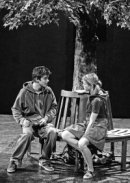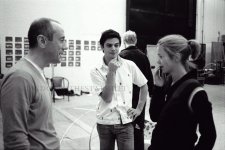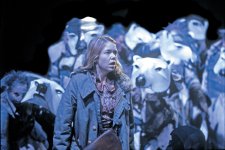Stage Adaptation
Cast and Crew | Materials | Reviews | Images | Effects |Stagework | Playbox | DiscussionOn the 20th December 2003, two members of our staff, Nick and Siobhan, attended the first showing of both parts of the His Dark Materials stage play in the Olivier Theatre, London. The overall opinion was that the play was an excellent adaptation of the books, considering the confining limitations of stage presentation.
The Actors
 We all knew that there was to be no children in the play and many were sceptical about how it would be possible for the two main characters to be played by adults.
We all knew that there was to be no children in the play and many were sceptical about how it would be possible for the two main characters to be played by adults.
Anna Maxwell-Martin did a great job as Lyra, easily showing her wildness in the earlier parts and you could see her maturing throughout the play. However, Anna was not quite able to express the true emotions of the character and a lot of the expression in her sadness and anger at various parts of the play were lost or not fulfilled to the scale it was in the books. Anna's voice is quite distinctive and the way she managed to pull of the accent of an Oxford wild child is very impressive.
Although not quite as true to the original character as Lyra was, Will was also played very well. Dominic Cooper was much more keen and forthcoming than the original Will, but in most places this was used effectively and made the growing relationship between the two characters more believable in the smaller timescale. Some of the deepness and maturity of the character was perhaps not appreciated because of the fact that his story, up until he met Lyra, was only told, rather than seen.
Roger was played very well, and his bond with Lyra was strengthened by the fact that you saw the two children meeting, instead of having their friendship thrust upon you. Russell Tovey did a great job of purveying the innocence and childlike confusion, which made him one of the most convincing characters.
As an ex-Bond, Timothy Dalton was perhaps a strange choice for Lord Asriel in the eyes of many fans, but he did pull it off very well. He presented some excellent dictatorial speeches, which were very convincing, however, a lot of the drive and hate behind Asriel was missing. The love he shows to Mrs. Coulter at the end of Book One remains and is pulled off very well.
Mrs Coulter is a difficult character to portray, as she is very manipulative and evil yet also kind and loving. Needless to say it took a lot of work to make it believable, which Patricia Hodge did admirably well. There were only a few points, specifically in Lord Boreal's house and in the Cave that the believability wavered. Otherwise she had a very powerful presence on the stage, which was aided by the Golden Monkey.
Iorek the armoured bear was really well done. He was the only one of the Panserbjørne who had the power and physical presence that made them such good characters. Although he was a bit too angry and hateful when we first meet him, by the time that it is over, we learn to love and respect him, as we did his character in the book.
The general opinion from fans is that the Gyptians are much more comical than in the books. One thing specifically was very out of character: When John Faa, played by Stephen Greif, is talking about how they are desperate to get the children back, he performs a short speech claiming "My Hammer is thirsty for Blood," which makes him sound more like a poor Lord of the Rings rip-off than our familiar Authoritarian Gyptian. As a whole, the gyptian men seem much more emotional and less willing to perform John Faa's will, as Farder Coram shows when he sneaks away to consult the Witch Consul, rather than going openly.
A totally new character was introduced in the play, named Brother Jasper, played by Ben Whishaw. He is a member of the church and regarded as "the finest Alethiometrist to pass through Jordan College". He seems to be the manifestation of what the Magistereum as a whole, is not. On stage he is very concise and seems to be almost normal, and as he shows when asked to retrieve Mrs. Coulter's locket, Ben Whishaw trembles at the thought of being near a sleeping woman. The way his hands fly to his frog/lizard/chameleon Dæmon whenever the character is troubled or shocked is very convincing. Overall Brother Jasper is the best-acted character in the play.
Father MacPhail, the head of the consistorial Court is played by Stephen Greif. In the play he is referred to as Father President and is much more commanding, forthright and devout than he seems in the books. He talks of possibly destroying the Magisterium and even comes across rather scary to the audience at some points. It is often hard to notice his Dæmon as, on several occasions, it looked like it was a pattern on his robes. Stephen Greif's accent at times sounds odd, however this does make him sound formidable and evil, as he is supposed to.
Niamh Cusack, who plays Serafina Pekkala, is the perfect image of a His Dark Materials witch. Obviously Niamh is Irish, but when her daemon, Kaisa was talking with a very strong Leprechaun style accent, it was a bit off putting. She did get a little annoying after a while and the way she said "I have Blackberries" just makes you want to laugh.
On the other hand, Ruta Skadi, played by Cecilia Noble, was very unrealistic and possibly the worst acted character in the play. It had nothing to do with Cecilia's talent as she made a very convincing Harpy; her character in the play just seemed angrier than she was in the books. Perhaps this was because the two characters Cecilia Noble plays are quite different, and the different roles became a bit muddled when she was playing the witch.
Lee Scoresby is well acted by Tim McMullan, but the actual character is wasted in this production. His only function is to get Lyra to Svalbard and to get Jopari to Will. These are the only places he is mentioned, making him very much like the Gyptians, in the aspect that they a shadow of their former selves. He has barely any words to speak and those that he does are needless. For example, the witches want to kill him because he is a man (don't ask) so he delivers his speech about what he wants for his future - which made no sense and is only there as a way of making him a justifiable character.
The harpies were great. The costume designers had overlooked nothing in the descriptions, and the wings in particular were really effective. Cecilia Noble's No-Name was scary; the girl next to us was jumping every time she spoke. Their voices were screeching, their "skin" all mottled and scaly and the way they moved and acted was quite disturbing, as indeed they were meant to be.
Last but not least, Jopari is played by Chris Larkin. The character is not referred to as Stanislaus Grumman in any part of the play, and he has much greater prominence than he had in the books, which works really well, most of the time. He made the Amber Spyglass; he teaches Asriel about Dust and seems infinitely wiser. He was, in short, quite unbelievable. One of the things we have been wondering about is how he knew about the bomb. In the play he got a messaged transmitted to him through the hole in his head. It was very unrealistic. He was not at all emotional when he saw Will in the land of the dead, and it was even comical in the moments before his death. He simply looks at Will and says, "You are my son", quite detached and uncaring and then he dies.
The Production
 After seeing the play, you can understand why it is impossible to take the production on tour without modifying the entire script. The stage revolves in three sections - an outside ring, and inside ring, and a small ring in the middle. These can all spin independently of each other, and there are doors in the side of the stage, which allows the outer ring to revolve, whilst everything else stays still, creating the illusion of travel. The audience can either see the entire circular stage, or only half of it, when a dividing wall cuts off the back from view.
After seeing the play, you can understand why it is impossible to take the production on tour without modifying the entire script. The stage revolves in three sections - an outside ring, and inside ring, and a small ring in the middle. These can all spin independently of each other, and there are doors in the side of the stage, which allows the outer ring to revolve, whilst everything else stays still, creating the illusion of travel. The audience can either see the entire circular stage, or only half of it, when a dividing wall cuts off the back from view.
Furthermore, the inner ring can also rise up, revealing a room inside, or a wall, or a platform of rocks. The small inside circle is not noticeable at first, so when you see the hot air balloon floating into the sky, or a rowing boat coming from above you, it is very impressive. The best use of the revolving sections is seen when Will is cutting a window through into his world: He and Lyra are in the Botanical Gardens, and when Will cuts, the tree and bench separate - one moving to the left, and the other to the right - we then see children on their respective sides, and when the window is closed, the tree moves back together. Thus we understand that although they are sitting on the 'same' bench, they are effectively in separate universes.
As well as the actual stage moving, video projection is used a lot, for example to create an aurora, to show Brother Jasper's presentation, or to project an image of the Gallivespians from the lodestone resonator. These were an excellent addition to the play, and combined with the music, the whole atmosphere was just wonderful.
Momentous praise is deserved of the designers and puppeteers of the Dæmons. The way they are depicted is just excellent. Heads and basic frames are made of the animal, and the eyes are illuminated by orange and yellow lights. When the dæmon is not being held by its respective human, it is manipulated by a puppeteer. These people are dressed all in black, with a black fencing mask over their head and face. The dog's tails wag, and other animals scurry around very believably. The Golden Monkey, in particular was brilliant. When it wasn't bouncing around over furniture, terrorizing everyone, the subtle way it was moved gave the impression that it was breathing, although it's cloth body was subject to breezes and once it got caught over an arm and the puppeteer was unable to sort it out for a few minutes.. The way in which the angels were represented was also quite impressive - they were transparent as much as they could be, considering they were still essentially puppets.
The Gallivespians were larger than they are described in the books, but this was most likely so people at the back of the theatre could see what was happening, while they were still small enough to show that they were tiny people. They were fully human shaped puppets, and ran about in a quite convincing fashion. When using the lodestone resonator, an image of the Lady Salmakia and Chevalier Tialys were projected onto a screen, so the audience could see actual people talking, helping create the illusion that they were real people.
Understandably, huge bears could not be used - instead we had human actors, covered in layers of creamy white clothes. They held a bear's head on one hand, and a huge claw on the other. They loped about convincingly, but the fight scene between Iorek and Iofur was too brief, it was unfulfilling, and didn't give the scene in the book justice.
The Story
 The main aspect every fan will want to know about is how true the stage play is to the books. Nicholas Wright has done an excellent job adapting the books for stage (read our separate review of the script). Since the trilogy is very long, it was obvious from the beginning that some content was going to be missed out. The story mostly follows true to the plot of the books. A lot of the scenes are greatly reduced, in order to fit it all in, but thankfully it does not compromise the integrity of the story.
The main aspect every fan will want to know about is how true the stage play is to the books. Nicholas Wright has done an excellent job adapting the books for stage (read our separate review of the script). Since the trilogy is very long, it was obvious from the beginning that some content was going to be missed out. The story mostly follows true to the plot of the books. A lot of the scenes are greatly reduced, in order to fit it all in, but thankfully it does not compromise the integrity of the story.
Much to the disappointment of many people, Mary Malone and the Mulefa subplot was missed out completely, with Serafina taking on the role of Mary as tempter. Serafina also wielded the Amber Spyglass, which had been given to her by Jopari. The spyglass was originally made by Mary, so it is not appreciated as much by the theatre audience as it is by those who have read the books.
Serafina was not the only one who is now two characters compacted into one the role of the witch Juta Kamainen, was played by Ruta Skadi. It came as quite a shock when she announced that she had been in love with Jopari! However, the strong will, pride and stubbornness of witches is depicted very well by doing this, since we are more in touch with one character, rather than seeing the different traits in different characters.
Unfortunately, the relationship between Lee Scoresby and Lyra was not built up as much in the play as it had been in the books. Lee seems more a companion of Jopari than a friend of Lyra. It was also disappointing that he just disappears. The scene at Alamo Gulch is missed out, so we do not know that Lee has died, so he is not in the Land of the Dead with Jopari or Roger.
As was mentioned earlier, the image of Serafina Pekkala, and of the witches in general, was accurate. However, the other aspects of the witches were not so impressive. Obviously, it was not possible for them to physically fly, but the way they portrayed them flying was slightly ridiculous it looked as if they were stirring the air whilst holding their cloud pine backwards - and the way that they screamed a lot was also a bit off-putting.
What was surprising, was that for many people, one of the key moments in the entire trilogy had been changed. Marzipan has become significant as the food that tempted Will and Lyra to fall in love. However, in the play, this had been changed to blackberries. This just seemed to make the entire scene seem less exotic and dramatic, and then the part near the end when Serafina appears with a basket and says, 'Lyra. Will. I've brought you blackberries.' is frankly laughable.
For the first time in the play, we were laughing at things not meant to be funny, except no one else was joining us.
There was quite a lot of misplaced humour during the progression of the play. At times, the actions of the Gallivespians in particular, were meant to be funny to the audience, and this was done really well. On the other hand, there were points in the play that were not meant to be funny, yet the audience were in hysterics. For example, when the Gallivespians and the Angels appeared on stage, at any time, even when the image of the Gallivespians Tialys and Salmakia were broadcast over the lodestone resonator, and were remotely unfunny, the audience were still crying with laughter.
In conclusion, apart from one or two more noticable changes, the script mainly stays true to the book. As the play runs its course, the actors will become more settled into their characters, because unfortunately at the moment, there is still a lot that could be better. The costumes and puppets are excellent, and after a time, the audience forgets the puppeteer, and sees the daemon or angel as a proper character. All in all, the play is excellent, considering the confines of stage production, and we are left with but one question by the end:
Blackberries??

